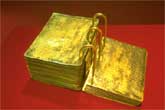|
by Tom Lovell 
Joseph Smith said that the set of plates was 8 inches long, 6 inches wide, and 6 inches thick, which would weigh about 200 pounds if made of pure 24K gold. That would have been a lot for Joseph Smith to have carried. But the plates could have weighed less and still have been gold. Metallurgist-blacksmith Reed Putnam has shown that hammered plates of 24K gold would weigh only half as much as a solid block the same size. That would make the plates about 100 pounds, a more reasonable weight for Joseph to have carried. However, Putnam also points out that if the plates were made of a common Central American alloy called tumbaga, made of 8K gold and copper, they would have weighed around 53 pounds. Interestingly enough, William Smith, brother. of the Prophet, lifted the plates while they were in a pillowcase and estimated that they weighed 60 pounds, and Martin Harris, one of the Three Witnesses, said that they weighed 40 to 50 pounds. William also said the plates were a mixture of gold and copper. Pure gold would be too soft to make useful plates. But tumbaga is remarkably tough, and resilient, even in sheets as thin as the gold plates are described as being (like thick paper, Emma said, or "not quite as thick as common tin," according to Joseph, Martin Harris, and David Whitmer). In ancient America, Tumbaga was commonly treated with a simple acid (such as citric acid), making it easy to engrave and turning it from its natural red to a "golden" color. Whether the plates were made of tumbaga or some other alloy, reasonable sense can be made of the physical description of the plates and of their possible metallurgical composition. (edited by David Van Alstyne) Home / For Latter-day Saints |